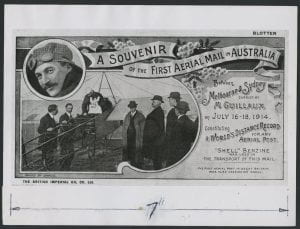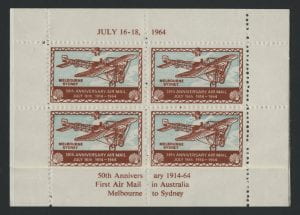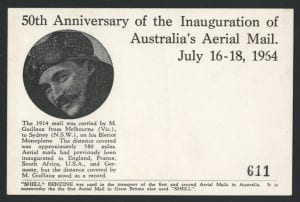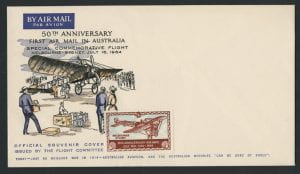The Many Facets of Ephemera
Samara Greenwood
Delving into the digitised items of the Shell Historical Collection, my attention was captured by one particular artifact. It is an image of a 1964 advertising blotter produced by Shell to commemorate the 50th anniversary of the first Australian airmail flight (Figure 1). I was intrigued by the ordinariness of the artifact, combined with its visual complexity and connection to a little-known historic event.

The image is a reproduction of a 1914 blotter designed to celebrate the original flight. Blotters, used to prevent the smearing of ink from fountain pens, were a common form of advertising from the 1900s until the 1970s, when the ballpoint pen became more widely used. They were a popular promotional item for commercial firms as the blotter would be kept on the desk of recipients, thereby acting as an everyday visual reminder of their product. In this instance, the blotter had the further purpose of commemorating a particular event, thereby cleverly combining commercial promotion, practical utility, and historic interest.
Visually, the cover image shows a rich entanglement of signs and symbols. The main image depicts the key event, showing the mail, the plane and the pilot with key (male) dignitaries clustered around. Above this, the inset photo depicts the famous French stunt pilot, Maurice Guillaux, who was a last-minute replacement for an American aviator who had crashed his plane while racing against an automobile in Rockhampton. Fortunately, Guillaux was at the time touring the country with his Bleriot XI Monoplane, performing aerobatic flying displays for hundreds of thousands of people. This connection to foreign celebrity and technological spectacle is then juxtaposed with symbols of Australian identity, such as the blossom surrounding the headline banner, providing a sense of Australian significance in an era of concerted nation-building.
Further appeals to the national pride of Anglo-Australians can be found in the text. For example, the advertisement calls out the importance of the flight as a “world’s distance record for any aerial post” before signalling Shell’s contribution and referencing a similar event in the ‘home country’ of Great Britain. We can also see how the Shell brand is being linked to pioneering aviation and the institutional authority of the mail service. In a further commemorative item (Figure 2), Shell produced a ‘semi-official’ postage stamp in which an illustration of the monoplane is surrounded by a border embedded with the Shell logo. In each case, we see evidence of Shell’s canny ability to interweave their commercial identity with the “images, symbols and myths that motivate people.” (Burant 1995: 192)
Beyond their visual aspects, these artifacts also provoke a more general interest in the original flight and its commemoration. In researching these events, I found several connections to other historical repositories. For example, Sydney’s Powerhouse Museum retains the original Bleriot XI Monoplane used by Maurice Guillaux, which he left in Australia on returning to Europe to fight in World War I. The Powerhouse has also produced a detailed 11-part blog series on the original flight. Through this, I discovered Shell, then the British Imperial Oil Company, only became a late sponsor of the event, and the flights cargo consisted of a rather eclectic mix of official government letters, 1785 postcards (which also included a promotion for Shell similar to the 1964 postcard shown in Figure 3) as well as products from other sponsors, including a quantity of Lipton tea and OT Cordials, “a chilli/fruit juice punch mix that was marketed as a healthful non-alcoholic ‘adult’ drink”.


With the aid of University of Melbourne archivists, further investigation into the Shell Collection uncovered additional unexpected gems. A box of non-itemised documents revealed a manila folder of correspondence between Australian authorities and Shell detailing their co-ordination of the commemorative efforts. On the front is a delightful handwritten note (struck through) stating the folder is ‘of no historical value,’ (2005.0048 unit 283 item 12/10). Also contained within the box is an annotated draft of a document titled 50 Years of Australian Air Mails written by philatelist and historian of Australian airmail, Nelson Eustis (2005.0048 unit 283 item 12/10). The publication was produced as a souvenir for the flight’s 50-year anniversary, and later reproduced on the 100-year anniversary. Interestingly, a 2008 article from The Sydney Morning Herald tells us that Nelson’s prized possession was an original postcard from the 1914 flight signed by Guillaux, which sold for $30,000 as part of his extensive estate (Cockington 2008).
As an historical researcher, I am continually fascinated by how a single object can open up such a diverse array of stories and connections. In this case, an intriguing object led me to study not only its visual and symbolic meaning but also its link to an historical story extending from 1914 through 1964 to 2014 and beyond. Rather than a single window on the past, such “bits and scraps of ages-gone-by” (Kolbet 1991:27) display a variety of facets, providing many suggestive pathways for further exploration.

Samara Greenwood is a PhD Candidate in History and Philosophy of Science. Samara’s thesis explores the varied ways changing societal contexts shape scientific practice through a multiple case study analysis.
References
Australian Screen. Shell Company of Australia. Accessed 9th September 2021 at https://aso.gov.au/titles/collections/shell-series/
Burant, J. (1995) ‘Ephemera, Archives, and Another View of History,’ Archivaria, 40 (Fall 1995), 189-198.
Cockington, J. ‘Flight of Fancy,’ The Sydney Morning Herald, September 3, 2008.
Kolbet, R. M. (1991) ‘Publish & Perish: Printed Ephemera and Social History,’ Books at Iowa, 55(1), 25-36.
Museum of Applied Arts & Sciences (Powerhouse). Bleriot XI monoplane. Accessed 9th September 2021 at https://collection.maas.museum/object/288461
Museum of Applied Arts & Sciences (Powerhouse). The Story of Australia’s First Airmail – Part 11. Accessed 9th September 2021 at https://www.maas.museum/inside-the-collection/2014/10/29/the-story-of-australias-first-airmail-part-11
Museum of Applied Arts & Sciences (Powerhouse). The Story of Australia’s First Airmail – Part 6. Accessed 9th September 2021 at https://www.maas.museum/inside-the-collection/2014/07/16/the-story-of-australias-first-airmail-part-6/
National Library of Australia Catalogue. 50 years of Australian air mails / H N Eustis. Accessed 9th September 2021 at https://catalogue.nla.gov.au/Record/6812431
Princeton University Library. Graphic Arts: Advertise with Blotter Paper. Accessed 9th September 2021 at https://www.princeton.edu/~graphicarts/2010/06/advertise_with_blotter_paper.html
Rickard, M (2000) The Encyclopedia of Ephemera: A Guide to the Fragmentary Documents of Everyday Life for the Collector, Curator, and Historian. Routledge.
University of Melbourne Archives. Shell’s Aviation Spirit. Accessed 9th September 2021 at https://archives.unimelb.edu.au/explore/exhibitions/past-events/primary-sources-50-years-of-the-archives/the_stories/shells_aviation_spirit
University of Melbourne Archives. Shell Historical Collection, 2008.0045.00792, 2008.0045.00793, 2008.0045.00794, 2008.0045.00795, 2005.0048 unit 283 item 12/10.
Victoria Collections. Advertising Material, Mid 20th Century. Accessed 9th September 2021 at https://victoriancollections.net.au/items/5ddb210221ea671a141ef2d9
Leave a Reply